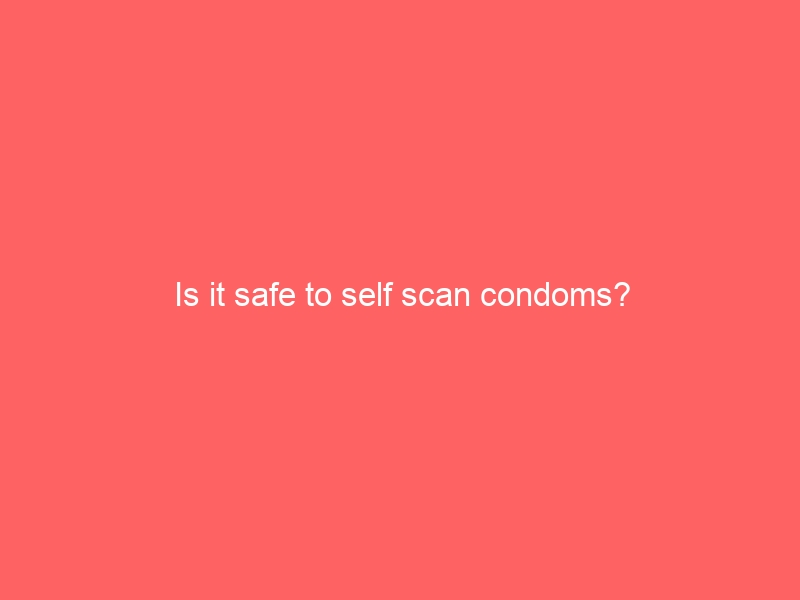In an era where self-service technology has become increasingly prevalent, the question arises: can you self scan condoms safely? This inquiry delves into a myriad of considerations, including privacy concerns, hygiene practices, and the overall convenience of self-scanning options. While the ability to discreetly purchase such products can be appealing, potential scanning errors and social stigma may also influence consumer behavior. Additionally, understanding the store policies regarding self-scanning is crucial for informed decision-making. This article aims to explore the various factors surrounding the safety and practicality of self-scanning condoms.
Privacy Concerns
Privacy concerns surrounding the self-scanning of condoms highlight the potential risks associated with personal data exposure during the purchasing process. Consumers may inadvertently share sensitive information through loyalty programs or payment systems linked to their purchases. The anonymity typically afforded by traditional checkout methods is compromised, raising questions about data security. Furthermore, retailers may collect and analyze purchasing patterns, which could lead to unwanted marketing or profiling. As such, individuals must be aware of the implications of their purchasing choices in a digital environment.
Hygiene and Cleanliness
Hygiene and cleanliness are paramount considerations when self-scanning condoms to ensure that the products remain uncontaminated and safe for use. It is essential to sanitize hands and the scanning environment before handling condoms. Additionally, the scanning device should be cleaned regularly to prevent cross-contamination. Operators must also ensure that the condoms are stored in a clean and dry location to maintain their integrity. Adhering to these hygiene practices is crucial for consumer safety.
The Convenience Factor
The convenience factor of self-scanning condoms offers consumers a discreet and efficient way to purchase contraceptive products without the need for direct interaction with store personnel. This method allows individuals to maintain privacy, which is particularly important for those who may feel uncomfortable discussing sexual health in public settings. Furthermore, self-scanning technology streamlines the checkout process, reducing wait times and enhancing the overall shopping experience. As retail environments evolve, the integration of self-scanning options aligns with consumer preferences for autonomy and control over their purchasing decisions. Ultimately, the convenience of self-scanning contributes to a more positive and empowering experience for consumers seeking contraceptive solutions.
Potential for Scanning Errors
Potential scanning errors may compromise the effectiveness of condoms, leading to unintended risks during use. Misinterpretation of the product’s integrity could result in inadequate protection against sexually transmitted infections and unintended pregnancies. Inaccurate readings may stem from various factors, including technical malfunctions or user errors. These potential discrepancies highlight the importance of rigorous quality control in the self-scanning process. Consequently, users must remain vigilant and consider the limitations associated with relying solely on self-scanning technologies for condom verification.
Social Stigma and Perception
Social stigma surrounding condom usage often influences individuals’ perceptions of self-scanning as a safe practice. This stigma can lead to feelings of embarrassment or shame, discouraging individuals from using self-scanning technology. As a result, many may overlook the benefits of enhanced safety and assurance that self-scanning provides. Perceptions shaped by societal attitudes can create barriers to adopting innovative practices that promote sexual health. Ultimately, addressing these stigmas is crucial for fostering a more informed and accepting attitude towards condom usage and self-scanning technologies.
Alternatives to Self-Scanning
Numerous alternatives exist for individuals seeking to ensure the quality and safety of condoms without relying on self-scanning methods. One effective approach is to purchase condoms from reputable manufacturers known for their rigorous quality control standards. Additionally, utilizing third-party testing certifications can provide reassurance regarding the product’s safety and reliability. Engaging in educational programs that provide information about proper storage and usage can further enhance condom effectiveness. Finally, consulting with healthcare professionals can offer personalized guidance and recommendations on the best products available.
Tips for Safe Self-Scanning
Ensuring accuracy in self-scanning requires careful attention to product details and adherence to scanning guidelines. Users should familiarize themselves with the layout of the self-scanning kiosk to avoid potential errors. It is essential to double-check that the correct barcode is scanned to ensure the right product is being purchased. Additionally, maintaining a steady hand while scanning can help prevent misreads or missed items. Finally, reviewing the transaction summary before finalizing the purchase can significantly reduce the likelihood of mistakes.
Understanding Store Policies
Understanding store policies regarding self-scanning can greatly influence consumer behavior and perceptions of safety when purchasing sensitive items like condoms. Many retailers have implemented specific guidelines aimed at safeguarding customer privacy and ensuring a seamless checkout experience. These policies often address the placement of self-scanning machines and the availability of staff assistance for sensitive purchases. Additionally, clear communication of return and exchange policies can alleviate consumer anxiety surrounding these intimate items. Ultimately, an informed understanding of these policies helps consumers feel more secure and confident during their shopping experience.
Conclusion
The exploration of self-scanning condom purchases reveals a complex interplay of privacy, hygiene, convenience, and societal perceptions. Awareness of potential data exposure and the importance of maintaining cleanliness during transactions is critical for ensuring consumer safety. The convenience offered by self-scanning can empower individuals, promoting autonomy in sensitive purchases. However, the risks associated with technological inaccuracies necessitate a focus on quality control and user education. Addressing societal stigmas surrounding condom usage is essential for fostering a more informed and accepting attitude toward innovative practices in sexual health.
If you’re curious about the complexities surrounding chastity devices in the adult film industry, I highly recommend visiting this insightful article: The Reality of Chastity Devices in Adult Film Industry. It offers a fascinating perspective that complements discussions about safety and personal choices, including self-scanning condoms. Don’t miss out on this engaging read!
